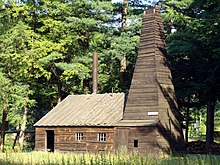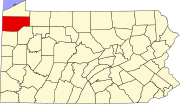
Venango County is a county in the Commonwealth of Pennsylvania. As of the 2020 census, the population was 50,454. Its county seat is Franklin. The county was created in 1800 and later organized in 1805. The county is part of the Northwest Pennsylvania region of the state.

Carter County is a county in the U.S. state of Oklahoma. As of the 2020 census, the population was 48,003. Its county seat is Ardmore. The county was named for Captain Ben W. Carter, a Cherokee who lived among the Chickasaw.

Centerville is a borough in Crawford County, Pennsylvania, United States. The population was 176 at the 2020 census, down from 218 at the 2010 census. It was established in 1812.
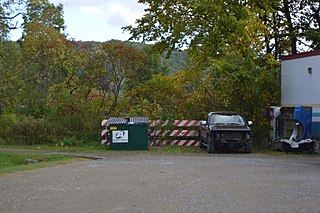
Oil Creek Township is a township in Crawford County, Pennsylvania, United States. The population was 1,702 at the 2020 census, a decrease from 1,877 at the 2010 census.

Corry is a city in northwestern Pennsylvania, United States. With a population of 6,217 at the 2020 United States Census, it is the second largest city in Erie County. Corry is a part of the Erie, PA Metropolitan Statistical Area. The city became famous in the late-19th and early-20th centuries for being the manufacturer of Climax locomotives.

Union City is a borough in Erie County, Pennsylvania, United States. It is located 22 miles (35 km) southeast of Erie. In the twentieth century, there were three large chair factories, planing and grist mills, a powdered milk plant, and several furniture factories. The population was 2,934 at the 2020 census. It is part of the Erie Metropolitan Statistical Area.

Oil City is the largest city in Venango County, Pennsylvania, United States. Known for its prominence in the initial exploration and development of the petroleum industry, it is located at a bend in the Allegheny River at the mouth of Oil Creek. The population was 9,608 at the 2020 census, and it is the principal city of the Oil City micropolitan area.

Sistersville is a city in Tyler County, West Virginia, United States, along the Ohio River. The population was 1,413 at the 2020 census. The Sistersville Ferry crosses the Ohio River to the unincorporated community of Fly in Monroe County, Ohio.

Edwin Laurentine Drake, also known as Colonel Drake, was an American businessman and the first American to successfully drill for oil.

The Drake Well Museum and Park is a museum in Cherrytree Township, Pennsylvania that chronicles the birth of the American oil industry in 1859 by Colonel Edwin Drake. The museum collects and preserves related artifacts. The reconstructed Drake Well demonstrates the first practical use of salt drilling techniques for the extraction of petroleum through an oil well.

Pithole, or Pithole City, is a ghost town in Cornplanter Township, Venango County, Pennsylvania, United States, about 6 miles (9.7 km) from Oil Creek State Park and the Drake Well Museum, the site of the first commercial oil well in the United States. Pithole's sudden growth and equally rapid decline, as well as its status as a "proving ground" of sorts for the burgeoning petroleum industry, made it one of the most famous of oil boomtowns.

Oil Creek State Park is a Pennsylvania state park on 6,250 acres (2,529 ha) in Cherrytree, Cornplanter and Oil Creek Townships, Venango County, Pennsylvania in the United States. The park is adjacent to Drake Well Museum, the site of the first successful commercial oil well in the United States, that was drilled under the direction of Colonel Edwin Drake. Oil Creek State Park follows Oil Creek, between Titusville and Oil City, and is on Pennsylvania Route 8. While the creek is the park's main recreational attraction, it also contains the sites of the first oil boomtown and much of Pennsylvania's original oil industry. The park contains a museum, tableaux, and trails to help visitors understand the history of the oil industry there, and an excursion train.
A wildcatter is an individual who drills wildcat wells, which are exploration oil wells drilled in areas not known to be oil fields. Notable wildcatters include Glenn McCarthy, Thomas Baker Slick Sr., Mike Benedum, Joe Trees, Clem S. Clarke, and Columbus Marion Joiner; Joiner is responsible for finding the East Texas Oil Field in 1930.
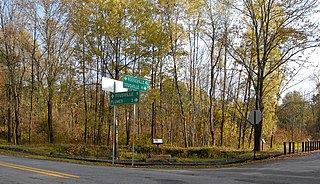
Petroleum Center is a populated place and ghost town in Cornplanter Township, Venango County, Pennsylvania, United States. In the 19th century, the name was also spelled "Petroleum Centre". The town today is almost deserted.
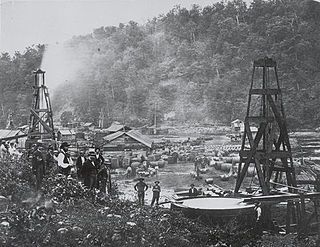
The oil rush in America started in Titusville, Pennsylvania, in the Oil Creek Valley when Edwin L. Drake struck "rock oil" there in 1859. Titusville and other towns on the shores of Oil Creek expanded rapidly as oil wells and refineries shot up across the region. Oil quickly became one of the most valuable commodities in the United States and railroads expanded into Western Pennsylvania to ship petroleum to the rest of the country.

The Oil Creek and Titusville Railroad is a tourist railroad that runs from Titusville to Rynd Farm north of Oil City in the U.S. state of Pennsylvania. The Oil Creek and Titusville Lines is the designated operator of the railroad, as well as the freight carrier on the line.
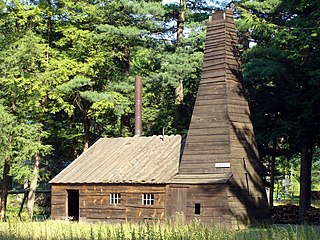
The Drake Well is a 69.5-foot-deep (21.2 m) oil well in Cherrytree Township, Pennsylvania, the success of which sparked the first oil boom in the United States. The well is the centerpiece of the Drake Well Museum located 3 miles (5 km) south of Titusville.
The Pithole Valley Railway was an ephemeral short line railroad in Venango County, Pennsylvania, constructed as a result of the Pennsylvania oil rush. The railroad was originally constructed in 1865 between Oil City, Pennsylvania, a local oil transportation hub, and the boomtown of Pithole, Pennsylvania. Constructed under the charter of the Clarion Land and Improvement Company, it was informally known as the Oil City and Pithole Branch Railroad. Although it was generally supported by the broad gauge Atlantic and Great Western Railway, it was built to standard gauge. Conflict with the Warren and Franklin Railway over the right-of-way along the Allegheny River led to a lawsuit which, in 1866, declared that the Oil City and Pithole had no right to operate along the river from Oleopolis, Pennsylvania to Oil City. That part of the line was sold to the Warren and Franklin, leaving the Oil City and Pithole with a 7-mile (10 km) line running north from Oleopolis to Pithole along Pithole Creek.
The Titusville Herald was a five-day morning daily newspaper published in Titusville, Pennsylvania, which covers news in Crawford County. Founded on June 14, 1865, it was the oldest daily newspaper in the Pennsylvania Oil Region until it ceased print on November 5, 2022.
The Pennsylvania Petroleum Railroad was a railroad in Pennsylvania originally chartered in 1871, during the Pennsylvania oil rush. Intended to provide an additional outlet from the Pennsylvania oil fields to Erie, Pennsylvania, it graded about ten miles of line in 1872, but was then caught up in the collapse of the Atlantic and Great Western Railroad, which halted the project. The company was foreclosed and reorganized under new names many times, but accomplished relatively little. It laid a short segment of line in 1890 in Titusville, Pennsylvania which was leased to a subsidiary of the New York Central to be used as a siding to a tannery. Further construction took place in 1913 with the idea of opening it as an electric railway to Cambridge Springs, but this, too, was never completed.






